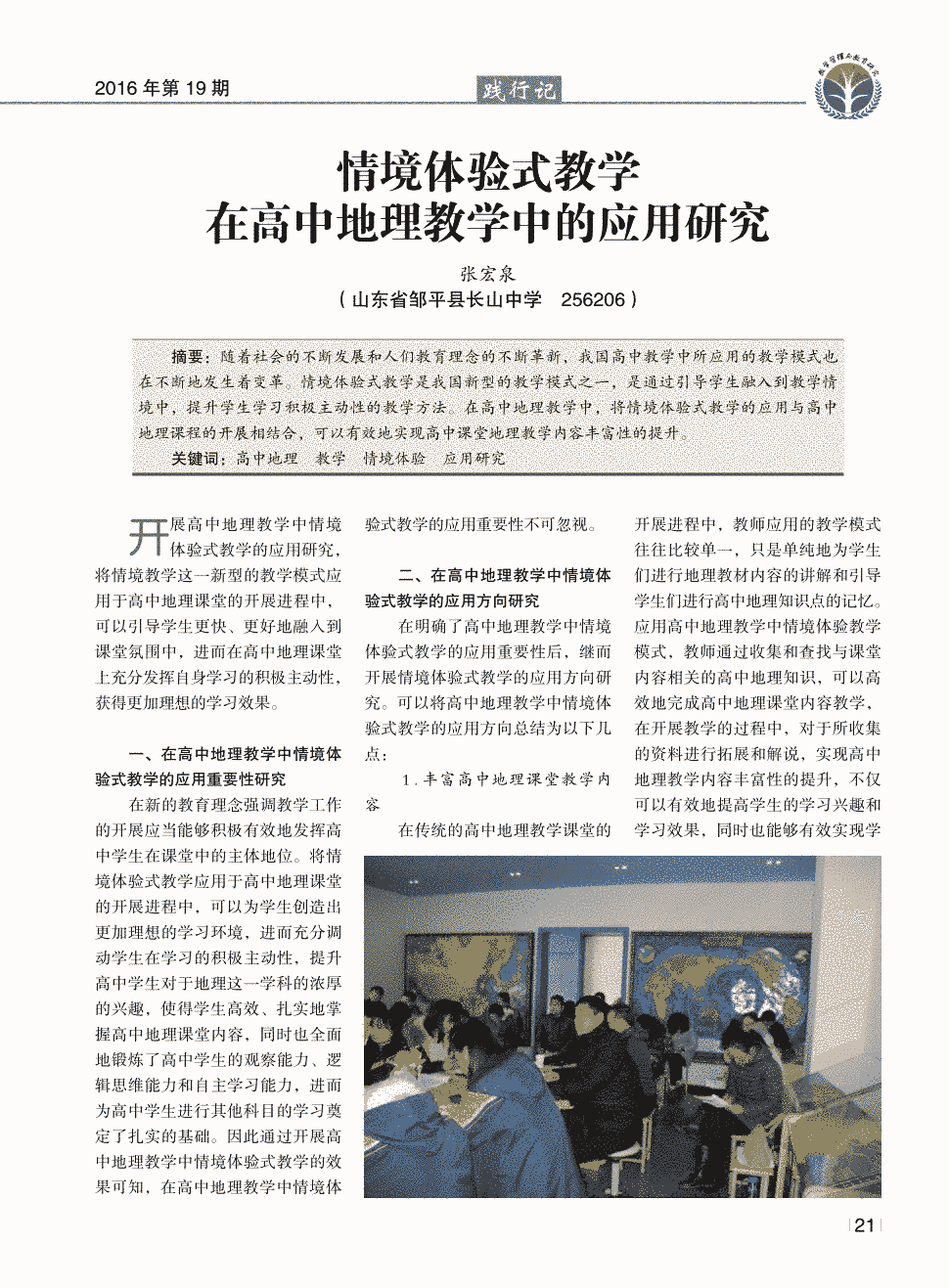范文,:翻转课堂教学模式下的高中地理教学设计研究(2)
希望通过本文的研究,为情景体验教学提供理论支持,同时为中学地理教育改革提供有价值的实践参考。
摘要范文之六:高中地理教学中学生主体性的培养研究
在80年代,主观教育引起了我国学术界的广泛关注。主体教育是以人的本质特征为基础,以解放人为前提的教育。高中地理教学中学生的主体性培养旨在提高学生的自主性、创造性和主动性,是其理论与实践所必需的。在教育实践中,笔者通过观察和调查发现,地理教学仍以传统教学模式为主,学生被动接受学习状态,“应试教育”仍是主要的教育形式。教师的教学观念没有改变,师生地位不平等。学生主体性的培养,事关学生的生存和发展,事关民族和全人类。社会的发展意义重大,主体性的培养是时代发展的要求,是地理时代特征的体现。
本文对高中地理教学中学生主体性培养的不足和必要性进行了深入研究。本文基于学生主体性培养缺失的命题,从主体性概念的解读入手,分析了主体性教育的内涵。对地理学科学生主体性培养的可行性进行了系统分析。在对学生主体性培养现状进行调查分析的基础上,分析了地理教学中学生主体性培养不足的原因,并提出了相关解决办法。同时,作者在教学。在实践中也进行了相关尝试,如改变教学方式,开展问题研究等研究课题,利用不同形式创造学习情境,培养学生的主体性。本文的创新之处在于为地理教学中学生主体性的培养填补了理论空白,针对这一问题的研究空白,就如何在地理教学中培养学生主体性提出了自己的看法。
本文最终结论如下:

(1)学生主体性的培养是可行的。本文对地理学在学生主体性培养中的优势进行了详细的分析和说明。地理学学科集时空性、综合性、实践性于一体。其特点有利于培养学生的选择性、创造性、主动性和综合能力。在地理教学中,学生主体性的培养具有很强的学科优势和实践可行性。
(2)改变教育方式是培养主体性的关键。培养学生主体性的关键是改变传统的教育方式,转变“应试教育”的观念,并以学生为主体教授地理。在教育过程中,给学生足够的时间和空间,充分尊重学生的思想和表达自由。
(3)学生主体性培养应注意的问题。地理教学中学生主体性的培养是一个长期而艰巨的过程。培养过程中应注意以下两个问题过程:①与地理课堂教学密切相关,同时避免表面上以学生为主导,本质上没有脱离传统教学模式的形式化教学。②主体性的培养要循序渐进.不要操之过急,不要试图通过几个案例或几个研究活动,这样可以培养学生的主体性,而且要持之以恒。
最后,作者针对具体教学中学生主体性的培养,设计了“为什么市区温度比郊区高”的教学活动,作为本文相关研究的案例补充。
高中地理教学论文摘要范文:高中地理教学案例设计研究
新地理学课程改革更加注重培养学生的自学能力、合作探究能力和创新意识。基于此,案例教学法受到广泛重视和积极应用,案例教学质量是案例教学法成功应用的关键因素。因此,如何设计一个适合地理教学的案例成为一线教师共同关心的问题。本文以《高中地理必修3》人民教育版为例,重点关注案例设计的步骤,通过教学实验检验设计步骤的可行性,进一步深化案例。设计理论与实践研究。
第 1 部分:简介
这部分主要总结了高中地理教学案例设计的研究背景和研究的理论意义和现实意义;总结了国内外当前的研究现状、相关研究成果和当前的研究问题,为论文提供了新的思路;简要说明论文研究的目的和内容,以及研究思路和方法。
第二部分:高中地理教学案例设计的依据
这部分主要分析高中地理教学案例设计的理论基础和实践基础。首先,阐述了多元智能理论、情境学习理论、新地理学课程观的主要观点,以及本文的指导意义;其次,解释了人民教育版地理必修课。 3 教材案例的特点和不足,以及对案例设计的指导和启示意义。
第三部分:高中地理教学案例设计的步骤
这部分是本文的核心内容。在对案例设计研究成果、存在的问题和设计依据进行分析的基础上,重点阐述了高中地理教学案例设计的四大步骤,包括目标设定、素材收集、内容编写和问题设定。 ,以及每一步的操作方法和注意事项,并提供具体的教学案例进行讲解和验证。
第四部分:高中地理教学案例设计教学实验

本部分主要根据高中地理教学案例设计的步骤进行教学实验,并通过学生问卷和教师问卷数据对实验结果进行定量和定性分析,最后进行总结和反思。
第五部分:结论
本节主要对全文进行总结,简要介绍本文的主要研究成果,并指出未来需要进一步研究和探索的问题。
高中地理教学第八篇论文摘要格式:翻转课堂在高中地理教学中的应用设计研究
新课改下的高中地理课程教学要求突出“趣味性、多功能性、情感性、务实性、高效性”的特点,以艺术魅力吸引学生、引导学生、培养学生、育人课堂教学,以达到培养人才、适应社会、适应未来需求的目的。历史在不断的改革中前进。就地理教学而言,它不仅面临着社会的改革发展,也面临着地理的不断更新和发展。教学本身也需要改革。 However, due to the long-term impact of test-oriented education, the subject itself has always been under-appreciated in the teaching of geography in middle schools in China. Meet the requirements of the new curriculum reform. Flipped classroom is also called upside-down classroom. Through the upside-down arrangement of knowledge transfer and internalization of knowledge, the role of teachers and students in traditional teaching has been changed, and the use of classroom time has been re-planned, realizing the traditional The innovation of teaching mode. However, due to the essence of China's current education system and the requirements of teaching equipment, flipped classrooms have fewer applications in teaching, and there are very few applications in geography teaching. There are also flipped classrooms' requirements for teachers' own teaching quality. , Leading many geography teachers to face the flipped classroom is more than willing and insufficient. This article aims to provide high school geography teachers with reference cases and theoretical guidance for flipped classrooms, improve the level of geography knowledge and skills of middle school students, and help improve students' interest in learning and classroom teaching Efficiency and strive to meet the requirements of the new curriculum reform. Based on the study of a large number of domestic and foreign related documents, this article has an in-depth understanding of the application status of flipped classrooms in China's high schools, combined with the teaching situation of China's high school geography, and proposed the application of flipped classroom teaching models to In the high school geography teaching, it is mainly divided into four parts: the introduction part briefly introduces the background and significance of the research, summarizes the current research status at home and abroad, and elaborates the research goals and innovations, research methods and technical routes; the second part is Relevant concepts and theoretical foundations mainly explain the concept of flipped classrooms, expounding the two major theoretical foundations-pedagogy theory and autonomous learning theory; the third part explains the principles and development techniques of geographic flipped classroom design and application, and give A case of the actual design and application of the geography flipped classroom is presented; the fourth part summarizes and sorts out the main conclusions of this article, and expounds the deficiencies of this article and the problems that need to be further studied.
Abstract of the Ninth High School Geography Teaching Paper: Research on Breakthrough Strategies for Difficulties in High School Geography Teaching
The difficulty of teaching refers to the knowledge and skills that it is difficult for students to fully understand and master in a short time under the guidance of teachers during the classroom teaching process, and it is difficult for teachers to introduce and express the knowledge and skills of explanation. High school geography is due to its own comprehensiveness and logic. The characteristics of high school geography teaching are the main factors affecting the effectiveness of geography classroom teaching. The difficulties of high school geography teaching are mainly distributed in the physical geography of compulsory one, especially in the first chapter "Planet Earth" and Chapter 1 The second chapter is the teaching content of "The Atmosphere on the Earth". However, the difficulty of high school geography teaching is a thing that varies from person to person, with a lot of subjectivity. The difference between students of different genders and different geographical foundations, as well as students and teachers There are great differences in the difficulty of different types of teaching content. This article aims to understand the differences, and combine actual teaching experience to provide some targeted teaching strategies for the breakthrough of high school geography teaching difficulties. This article is divided into four researches. Two parts: The first part is the introduction. It mainly includes four parts of thesis problem, research significance, research methods, and research status. The second part is the foundation of this article. It mainly defines the difficult concepts of high school geography teaching, and high school geography teaching The characteristics of the difficulties and the reasons for the difficulties in high school geography teaching are sorted out and analyzed. The third part is the main part of this article. First, according to the People's Education Edition "High School Geography Compulsory Teacher Teaching Book", "High School Geography New Curriculum Standard", "Geography Entrance Examination" Explanation”, the general classification of the knowledge points of the textbook content, and the compilation of a high school geography teaching difficulty questionnaire. Then, the statistical difference analysis of the high school geography teaching difficulty questionnaire is carried out to find out that students with different geographical foundations and different genders have a compulsory high school geography. The first and second chapters are different in the difficulty value of different types of teaching content. The fourth part is the breakthrough strategy of high school geography teaching. It is mainly based on the analysis results of the high school geography teaching difficulty survey data, respectively from the teaching plan arrangement and the students' strong geography foundation Four perspectives of weakness, teaching content type, and students’ cognitive law put forward a four-dimensional teaching strategy for breakthroughs in high school geography teaching.
厂家也是下血本了